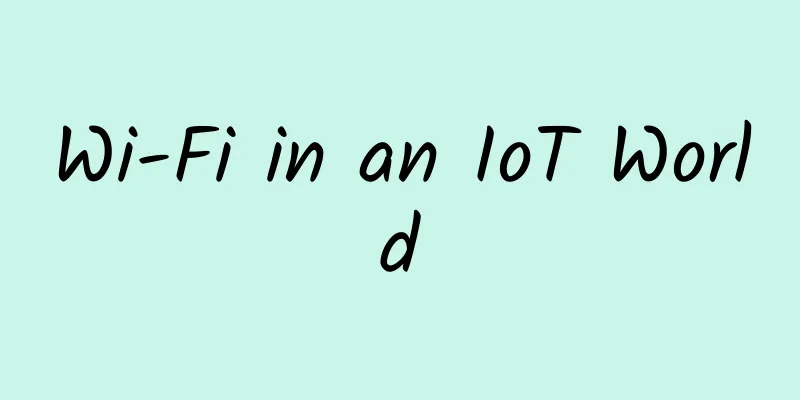Wi-Fi in an IoT World

|
We’ve written quite a bit about Wi-Fi, but what I’ve noticed lately is that almost everyone is talking about NB-IoT, LTE-M, LoRa, Sigfox or BLE, ZigBee, Z-Wave, so I’m like, what’s up with Wi-Fi?
As we wrote in a previous article, the AC version of Wi-Fi can deliver speeds of over 1 Gbps, but its range is usually limited to less than 100 meters. In addition, there are new Wi-Fi standards being developed for the IoT: Wi-Fi Halow (802.11ah), which was released in the fourth quarter of 2017, and HEW (802.11ax), which is expected to be finally officially released in 2019. Of course, Wi-Fi cannot compete with the wide-area coverage provided by low-power wide-area networks (LPWANs), and it is also losing its advantage over mobile networks in terms of indoor coverage (houses, buildings). In addition, multinational companies are actively promoting IoT deployment. From this perspective, if you are a vendor or developer and do not want to worry about network connectivity anywhere in the world, in cities or rural areas, in the wild or underground, then Wi-Fi will definitely not be the preferred solution for IoT development. Furthermore, all IoT market studies highlight security as a major issue, which worries end users the most when it comes to IoT implementations. Wi-Fi systems have also had problems when it comes to security – just remember the Key Reinstallation Attack (KRACK) or look at some of the widely used Wi-Fi hacking devices. Since this is a known weakness of Wi-Fi networks, they addressed this issue by developing HotSpot 2.0 which focuses on protecting the 802.11 radio interface, thus providing the same level of security as mobile networks. Of course, mobile networks are not completely secure, but mobile network operators cannot afford network outages or user data theft, so they do have some dedicated teams to deal with these issues. For IoT solutions using Wi-Fi connectivity, coexistence issues with LTE-U and other unlicensed cellular technologies operating in the same frequency bands as Wi-Fi may still be an issue. However, not everything about Wi-Fi is so bleak. It is a mature technology and is widely used in our homes and offices, so it will definitely exist for a long time. When it comes to IoT applications, Wi-Fi will mainly appear as part of smart home solutions (for home appliances, entertainment and lighting) and consumer devices, and both markets are very huge. (Source: IoT Home) Halow (there are no commercial Wi-Fi Halow access points or routers on the market so far) and Hew (802.11ax) will bring new Wi-Fi potential to the IoT, but they will first have to compete with other connectivity solutions in the same market. |
<<: In the 5G era, what sparks will cloud computing and 5G create?
>>: Inventory | 7 major acquisitions in the cybersecurity field recently
Recommend
spinservers: $69/month US server - E3-1280v5, 32G memory, 1TB NVme hard drive, 10Gbps bandwidth
spinservers recently offers special discount code...
The decline in operators' ability to generate revenue will affect the rapid deployment of 5G
The report on the economic operation of the commu...
Maxthon Hosting: CN2 GIA line VPS monthly payment starts from 54 yuan, and you can choose Los Angeles/Hong Kong/Korea and other data centers
At present, the best domestic access lines for ov...
The US 5G license auction amount has reached 69.8 billion US dollars, breaking the historical record
The Federal Communications Commission (FCC) is co...
How to implement TCP connection and communication with Python?
Network connection and communication are the know...
[Black Friday] TMThosting: 30% off monthly payment for Seattle high-security VPS, 10% off for dedicated servers, supports Alipay
TMThosting has released this year's Black Fri...
5G business continues to advance rapidly, and it is expected that by 2025, China's 5G connections will account for 40% of the world
[[436586]] According to GSMA think tank statistic...
ChatGPT and 5G messaging: the perfect combination of new artificial intelligence and new communications
At present, the hottest topic is none other than ...
The third phase of bidding for 5G main equipment has seen an increase in quantity and a decrease in price. China's 5G construction has shown three major changes
The results of the bidding for 5G wireless main e...
What are the differences between Bare Metal switches, White Box switches, and Brite Box switches?
In today's era of increasingly dynamic IT env...
What role does Wi-Fi-6 play in the field of industrial IoT?
5G technology has enough advantages to support so...
What? You need to change your SIM card to use 5G?!
Since 5G was officially put into commercial use l...
The difficulty of operation and maintenance has reached a new level - it does not exist!
What is the data center most afraid of? Power out...
From the SPACE matrix, is 5G on the road to success?
In September 1830, the world's first intercit...
Ruijie Networks Creates China's First Wireless Office Wi-Fi for "Medical Innovation Space"
In the "Precision Medicine Baccarat" pu...









